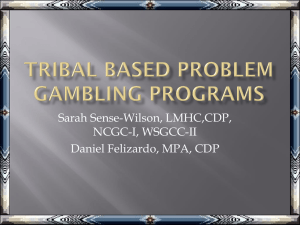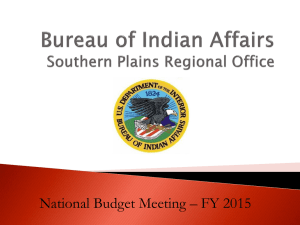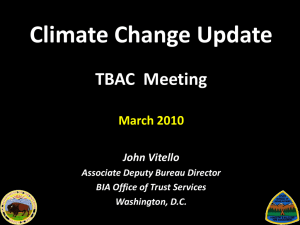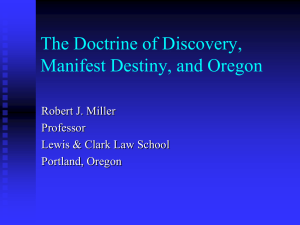Jaeger – Public Law 280 and Alaska Tribes
advertisement
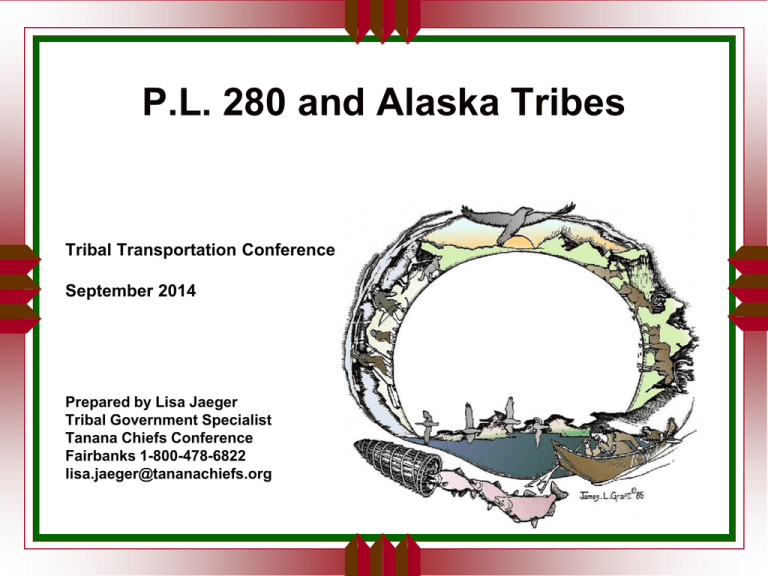
P.L. 280 and Alaska Tribes Tribal Transportation Conference September 2014 Prepared by Lisa Jaeger Tribal Government Specialist Tanana Chiefs Conference Fairbanks 1-800-478-6822 lisa.jaeger@tananachiefs.org “It’s often said that Alaska is unique in terms of federal Indian law, my own view is that all Native Americans are unique, each individual Native American nation is unique. Its own history, its own culture, its own relationship with the United States. And so to say that Alaska is unique is nothing more than saying Pueblos are unique, or the Navajo’s are unique, they are, and that ought to be acknowledged.” Dave Case 1988 : Alaska Supreme Court decided that there were no tribes in Alaska except for Metlakatla and possibly a few others (Stevens Village Management case) 1986, 1987, and 1992: Native Village of Nenana v. Dept. of Health and Human Services, In re K.E., In re F.P., In re W.M. (Alaska Court System)…even if there were tribes in Alaska, Public Law 280 terminated any tribal jurisdiction tribes might have had. 1989: Nome Eskimo Community Case, Alaska Supreme Court ruled that land can’t be taken away from an entity organized under the Indian Reorganization Act. 1990s 1991: Blatchford v. Native Village of Noatak and Circle Village. US Supreme Court ruled against Noatak and Circle requests for state revenue sharing, but did not review the part of the case from the lower court that decided that both Noatak and Circle were both tribes. 1993: List of federally recognized tribes issued to make it clear that the tribes in Alaska were indeed tribes and were to be given the “same privileges and immunities’ as Lower 48 tribes 1994: Confirmed by Congress through the Tribal List Act. 1990s Tribal courts in the TCC Region continued to conduct child custody and child protection cases, even experiencing some cooperation from state agencies. From somewhere in the 1990s, the number of children in custody began to run around ½ in tribal custody, and ½ in state custody. (currently around 150 child protection cases in each). Some tribal courts were/are also addressing misdemeanors in a civil manner, domestic violence, banishments, trespass, animal control, alcohol regulation, status offenses, etc. 2000s 2001 : C.R.H. Nikolai case (originally Chickaloon was also involved), State Supreme Court decided that Alaska Court System could transfer ICWA cases to tribes. 2003: Perryville v. Tague (Alaska Court) Alaska tribes have the right to banish a member from the village due to violent behavior and to have the Alaska Court System and troopers assist in enforcing their orders 2009: Kaltag v Hogan (Federal Court) Alaska tribal courts have jurisdiction (concurrent with the State) to initiate and hear child adoption cases. They are entitled to full faith and credit. 2011: Alaska v. Native Village of Tanana (Alaska Supreme) Tribes have the authority to initiate child protection cases under the Indian Child Welfare Act and under their inherent authority. Current Picture of Tribal Jurisdiction Clear Jurisdiction: Exclusive • Determining membership/citizenship • Internal affairs, determining own form of government, and tribal justice system Becoming more clear: Concurrent • Domestic relations, child protection, adoption, domestic violence when tribal members are involved Less clear: Concurrent • Infractions, status offenses, misdemeanors • Enforcing regulatory law – Best legal theories for these are protecting the health and safety of the tribe and tribal members, when necessary to regulate internal affairs, and when parties consent No Tribal Jurisdiction • Over matters outside the village, not involving tribal members or affecting the tribe…or criminal jurisdiction over non-Natives Tribal Government Operations Code Alaska tribal constitutions are different in the provisions they contain, so codes each tribe needs will vary. • Tribal council structures • Jurisdiction of the tribe • Details about waiving sovereign immunity • Procedure for adopting, amending and repealing ordinances • Ethic standards for tribal council and officials • Types of meetings, notification of meetings, quorums for tribal meetings • Elections procedures • Popular participation in government, initiative, referendum, recall, removal • Rights of tribal members • Membership and enrollment • Cooperative agreements Judicial Code • Tribal court structure – who are the judges? – How are they seated? – What length of terms do they have? • Tribal court procedures – How do cases get to the tribal court? – Basic hearing procedures – Rules for witnesses, evidence • Appellate court structure and procedures – Who are the judges for the appellate court • Circle Court – What kind of cases will they hear? – How are the circle participants selected? Domestic Relations Code Child custody disputes and formalizing agreements Child protection Terminating parental rights Foster home licensing Adoptions Guardianships Marriage Divorce/annulment Probate Elder Protection Domestic Violence Civil Law and Order Codes Jurisdiction for Alaska tribes is less secure for handling these types of cases than it is for child custody for example, but many tribes are handling infractions, status offenses, and misdemeanors as a civil manner Some tribes have agreements with the state for handling juvenile law and order cases, some are doing circle sentencing recommendations on state cases, others handle these cases without a written agreement Types of Ordinances include: Alcohol regulation Underage drinking Trespass Vandalism Theft Minor assaults Truancy Curfew Disorderly conduct Misuse of firearms Traffic – speeding - DUI Harassment Health and Safety - Environmental Ordinances Animal Control Abandoned Vehicles Nuisances Fireworks Environmental regulation • Solid waste • Littering • Burn barrels • Hazardous waste • Hazardous materials • Outhouses and human waste • Water quality Land Management Ordinances • Council powers over land issues • Rights of tribal members and land use • Acquisition of land procedures • Managing tribally owned lands • Tribal land assignments • Trespass • Land use planning policies and procedures Natural and Cultural Resources Ordinances • Artifacts and Human remains • Cultural use of Wildlife • Protocol for Research on the tribe, tribal land, and tribal cultural resources • Management policies and procedures for natural resources Tribal Business Ordinances • TERO – Tribal Employment Rights Ordinance • Management policies and procedures for tribal businesses • Utilities In spite of the lack of recognition by the State of Alaska, and the State’s insistence that P.L. 280 terminated tribal jurisdiction if tribes did truly survive ANCSA, Alaska tribes pursued exercising their sovereignty in the 1970s and 1980s. It has been by exercising their sovereignty that brought forth the court cases that proved P.L. 280 did not terminate their jurisdiction and that they have jurisdiction over a variety of subjects.
